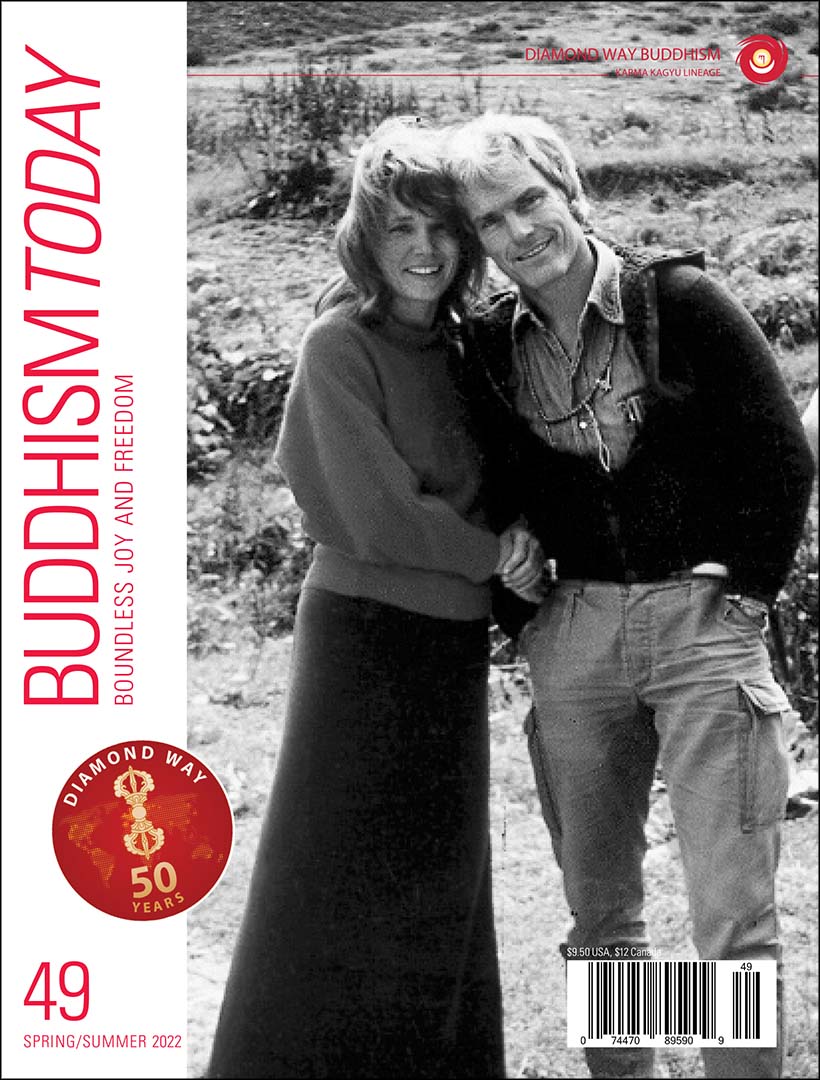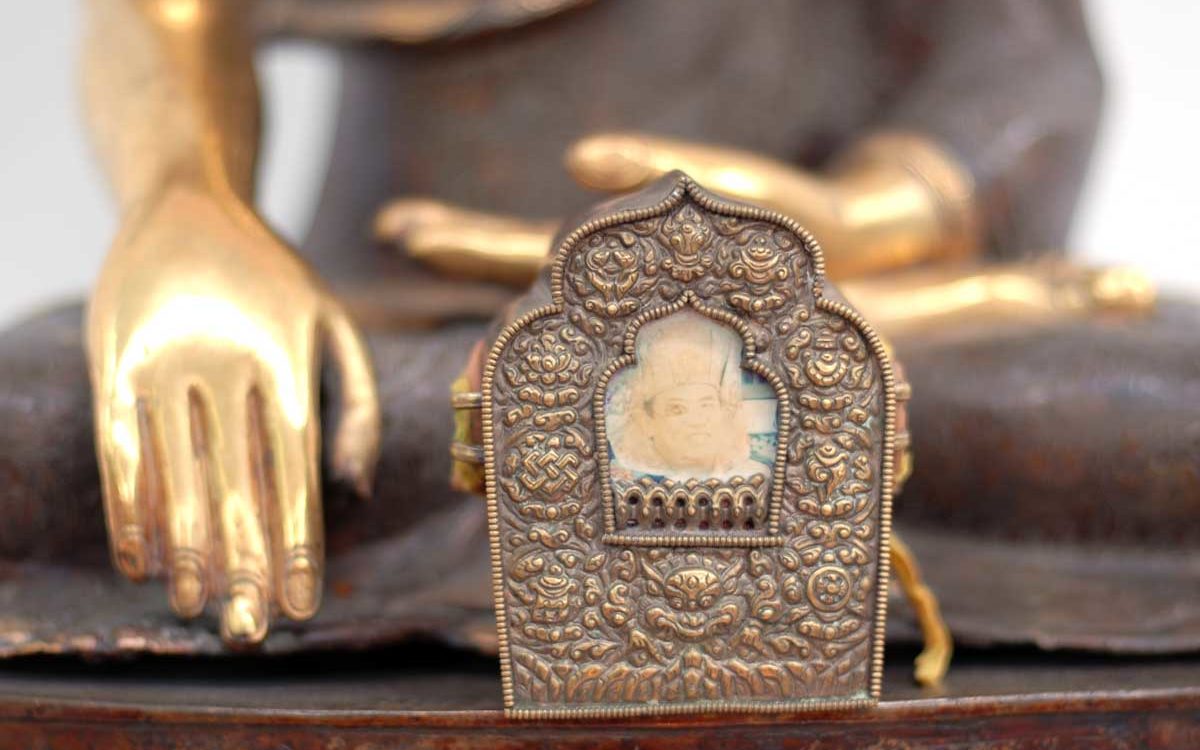Transmission in Diamond Way Buddhism
by Manfred Maier | Issue 21
To practitioners of the Karma Kagyu school, the term transmission is of vital importance. This is seen in the term Kagyupa: the syllable Ka means transmission. Karma Kagyu is the living tradition of the four transmissions, which Tilopa received from the Indian masters Nagarjuna, Ngagpopa, Lawapa, and the Dakini Kalpa Sangmo. The experience of this transmission as the ultimate insight into the nature of mind was passed on by realized masters over many centuries, in a close exchange between teacher and student. It is for this reason that it is still alive today. When we meditate with our friends in the center, we connect into this stream of realization.
Students encounter a variety of methods and explanations within Buddha’s complete teachings. These teachings correspond to the different potentials and perspectives of various people, and therefore there are many possibilities for learning and development. My teacher in secondary school often wrote the following lines into the notebooks of his students, “There are three ways to learn. Learning by experience: this is the hardest. Learning by reflection: this is the noblest. Learning by imitation: this is the fastest.”
When learning by experience, action precedes full understanding. Since the way to the goal is not clear, one simply tries something out. It is like an experiment which one is not certain will bring the desired result. If everything goes well, one has made a step on the way. If it goes wrong, one is at least richer by experience.
Learning by reflection may help one avoid making mistakes, but thoughts are only a small fraction of our totality. It often takes a lot of time until the understanding is transformed into experience.
When one learns by imitation, one learns from an already functioning example. The steps of trial and error and of contemplation were already performed by the master whom one is imitating. Imitating others is not a good idea when attempting technological development; most creative people like to work on their own ideas and innovations. But imitation is the best way to learn about human abilities and qualities, since it gives the fastest results. It is a spontaneous way of learning that, after recognizing certain qualities, aims directly at transformation. If the learner chooses a perfect example, one is largely protected against confusion and can look forward to an inspiring phase of learning.
The example of Buddha’s life shows the first two possibilities as a part of his own story of accomplishment. He practiced with many masters in the woods of Northern India, but he realized that their teachings were not able to lead him beyond concepts and ideas. As an ascetic, he tried to break through to the ultimate experience by absolute deprivation, until he became aware that the mind does not work properly in a half-famished body.
The third kind of learning was not known at his time: the one of imitation or identification, as we now call it. He himself was the one who would bring this method into the world by his own accomplishment. In Buddha’s teaching it is clear what should be learned; liberation and enlightenment is the goal. Enlightenment is an unconditional state of mind beyond thoughts and ideas, which expresses itself as joy, fearlessness, and love and appears spontaneously and effortlessly for the good of all.
The question of how we develop towards enlightenment has many aspects and can be roughly divided into two categories. The first is working with conditions that lead to the freedom of mind. These are positive actions, good impressions, compassion, and wisdom. This is the step-by-step way of changing habits and views to gain more insight and an ultimate experience. The second group is being introduced into the absolute by a master, who opens the way of identification, showing the goal itself, where transmission is of fundamental importance.
A story from Tilopa’s life tells us about this: One day, while Tilopa was studying the Prajnaparamita teaching, an old woman appeared in front of him. She became interested while looking at the texts and asked, “My son, what are you doing there?” He answered, “I am studying.” She raised her eyebrows and said, “Yes, the teachings are profound, but the way is hard and leads through many lifetimes. If you really want to understand their meaning, I know a way that is fast and has few obstacles.” Tilopa realized she was a dakini and answered, “Yes, I very much wish to accomplish the direct experience of the teachings.” She then showed him the Mandala of Highest Joy as a power field of energy and light in front of him in space. That way she gave him a direct transmission of the blissful nature of his mind and taught him how to identify himself with the absolute aspect of his mind, so he could go through to an unbroken experience of highest insight and joy.
If we wish to follow this way of showing the goal, then an experienced teacher is essential. He is the source of inspiration and transmission and makes it possible for a student to discover the unconditional qualities and abilities within oneself, again and again. In this case, teacher does not mean anything personal, but is an example of the unconditioned experience on two legs. By looking into the teacher’s mind, one looks into a mirror of one’s own mind. The two are not different in their absolute expression.
The process of transmission, which has a special importance in the Diamond Way and the Great Seal (Mahamudra), can be encountered in various areas of life. It happens every time an exchange includes a sharing of experiences beyond words. Every expression of a physical or mental ability becomes a direct experience for the attentive student, when one recognizes these qualities in the example of the teacher. If the student’s conditions are good, one can directly transfer what is shown and in that way, make big leaps in his development. If human connections are supported by confidence and openness, whole levels of experience can be shared. If one has a lot of joy, it is easily awakened in others. If one is loving, this quality becomes an immediate experience for others.
For a living transmission in the understanding of the Diamond Way to happen, different fortunate conditions are required. In short, it is mainly about the connection to the outside, to the teacher, who shows us the nature of mind and to the inside, to the perceiver.
Buddha taught that all sentient beings have the buddhanature. That which is conscious and perceives, the mind, is open like space, radiantly clear and without boundaries. Buddha’s experience is to recognize the nature of the experiencer in this way. If our mind were free of ignorance and the mixed feelings that stem from ignorance, all its unconditioned aspects would spontaneously and effortlessly manifest. Whereas limited consciousness is trapped in liking and not liking and is scattered between past and future, the liberated mind rests spontaneously and effortlessly in the here and now. This is what we get mirrored by the teacher, the spontaneous mind beyond concepts and attachments. This is in the end, our timeless nature. Often the mind is compared to a diamond: indestructible, radiant, and clear. The more the diamond of the mind is freed from obscuring veils, the more one becomes aware of one’s own ultimate nature. The connection to the inside awakens. If we then meet the unshakably joyful space of the mind of our teacher, we discover the same qualities in our mind and transmission has already happened. From this moment onward, something is awakened that we are not able to forget so easily. A view of ultimate importance is established. Some experience it as a second birth or like falling deeply in love. The life stories of our transmission lineage show inspiring examples for this. From the recognition of the shown goal, there is more and more a certainty from which trust and openness naturally arises. If the mind is free from doubts, devotion can develop. The more of our totality we use, the faster we achieve our goal. The transmission of the teacher leads the student to more autonomy, because there is no greater independence than the growing trust into the indestructible space of our mind. If we want to look directly at the perceiver and make that our main practice, transmission is essential.
Although the nature of mind is exactly the same for Buddha and all humans, this is often not recognized, because of ignorance. Everyone all over the world knows what he or she experiences and whether he or she likes it or not, but only the very few know who experiences all of that. Just like the eye, the mind perceives and experiences the outer world, but is barely, if at all, aware of itself.
Now, if like Tilopa we want to look directly at the experiencer, the core of our practice, then transmission is essential. The teacher is necessary, as the holder of the ultimate insight and power. If we look at the history of the realized ones and pay attention to their teachers as the source of inspiration, we can see that transmission can happen in myriad ways.
Besides the formal transmission by empowerments into the different aspects of mind, like Highest Joy, Wisdom Buddha, or Diamond in Hand, there is the transmission of the yogi, also called accomplisher. Free from an outer form, here the teacher represents the freshness of mind. By the close connection to his students, he is always ready to show them the mirror, wherever their openness appears. That can happen while running into each other between toilet and lecture hall, during the quiet sharing of the same space, or whilst driving fast on the highway.
Even if the teacher is far away traveling, the student can rest in the transmission of the teacher and can always gain new power and insight. With each transmission and inspiration, the level of experience is raised and the trust into the mind is strengthened. The richness of mind is the goal and, at the same time, the way.
To keep this certainty and experience in the troubled waters of daily life is part of our practice and at the same time the best way to express gratitude to our teacher. Here it is useful to remember Lama Ole’s teaching on transmission: “Highest truth is highest function. The more there is love and joy, insight and power; the closer we are to truth.”





